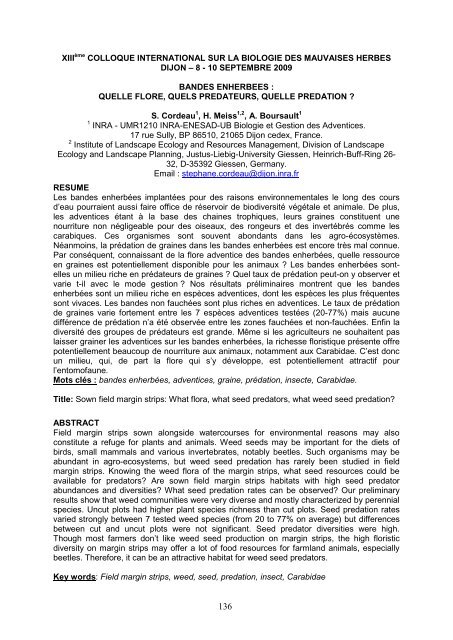Diversifying crop rotations with temporary grasslands - Université de ...
Diversifying crop rotations with temporary grasslands - Université de ...
Diversifying crop rotations with temporary grasslands - Université de ...
Create successful ePaper yourself
Turn your PDF publications into a flip-book with our unique Google optimized e-Paper software.
XIII ème<br />
COLLOQUE INTERNATIONAL SUR LA BIOLOGIE DES MAUVAISES HERBES<br />
DIJON – 8 - 10 SEPTEMBRE 2009<br />
BANDES ENHERBEES :<br />
QUELLE FLORE, QUELS PREDATEURS, QUELLE PREDATION ?<br />
S. Cor<strong>de</strong>au 1 , H. Meiss 1,2 , A. Boursault 1<br />
1<br />
INRA - UMR1210 INRA-ENESAD-UB Biologie et Gestion <strong>de</strong>s Adventices.<br />
17 rue Sully, BP 86510, 21065 Dijon ce<strong>de</strong>x, France.<br />
2<br />
Institute of Landscape Ecology and Resources Management, Division of Landscape<br />
Ecology and Landscape Planning, Justus-Liebig-University Giessen, Heinrich-Buff-Ring 26-<br />
32, D-35392 Giessen, Germany.<br />
Email : stephane.cor<strong>de</strong>au@dijon.inra.fr<br />
RESUME<br />
Les ban<strong>de</strong>s enherbées implantées pour <strong>de</strong>s raisons environnementales le long <strong>de</strong>s cours<br />
d’eau pourraient aussi faire office <strong>de</strong> réservoir <strong>de</strong> biodiversité végétale et animale. De plus,<br />
les adventices étant à la base <strong>de</strong>s chaines trophiques, leurs graines constituent une<br />
nourriture non négligeable pour <strong>de</strong>s oiseaux, <strong>de</strong>s rongeurs et <strong>de</strong>s invertébrés comme les<br />
carabiques. Ces organismes sont souvent abondants dans les agro-écosystèmes.<br />
Néanmoins, la prédation <strong>de</strong> graines dans les ban<strong>de</strong>s enherbées est encore très mal connue.<br />
Par conséquent, connaissant <strong>de</strong> la flore adventice <strong>de</strong>s ban<strong>de</strong>s enherbées, quelle ressource<br />
en graines est potentiellement disponible pour les animaux ? Les ban<strong>de</strong>s enherbées sontelles<br />
un milieu riche en prédateurs <strong>de</strong> graines ? Quel taux <strong>de</strong> prédation peut-on y observer et<br />
varie t-il avec le mo<strong>de</strong> gestion ? Nos résultats préliminaires montrent que les ban<strong>de</strong>s<br />
enherbées sont un milieu riche en espèces adventices, dont les espèces les plus fréquentes<br />
sont vivaces. Les ban<strong>de</strong>s non fauchées sont plus riches en adventices. Le taux <strong>de</strong> prédation<br />
<strong>de</strong> graines varie fortement entre les 7 espèces adventices testées (20-77%) mais aucune<br />
différence <strong>de</strong> prédation n’a été observée entre les zones fauchées et non-fauchées. Enfin la<br />
diversité <strong>de</strong>s groupes <strong>de</strong> prédateurs est gran<strong>de</strong>. Même si les agriculteurs ne souhaitent pas<br />
laisser grainer les adventices sur les ban<strong>de</strong>s enherbées, la richesse floristique présente offre<br />
potentiellement beaucoup <strong>de</strong> nourriture aux animaux, notamment aux Carabidae. C’est donc<br />
un milieu, qui, <strong>de</strong> part la flore qui s’y développe, est potentiellement attractif pour<br />
l’entomofaune.<br />
Mots clés : ban<strong>de</strong>s enherbées, adventices, graine, prédation, insecte, Carabidae.<br />
Title: Sown field margin strips: What flora, what seed predators, what weed seed predation?<br />
ABSTRACT<br />
Field margin strips sown alongsi<strong>de</strong> watercourses for environmental reasons may also<br />
constitute a refuge for plants and animals. Weed seeds may be important for the diets of<br />
birds, small mammals and various invertebrates, notably beetles. Such organisms may be<br />
abundant in agro-ecosystems, but weed seed predation has rarely been studied in field<br />
margin strips. Knowing the weed flora of the margin strips, what seed resources could be<br />
available for predators? Are sown field margin strips habitats <strong>with</strong> high seed predator<br />
abundances and diversities? What seed predation rates can be observed? Our preliminary<br />
results show that weed communities were very diverse and mostly characterized by perennial<br />
species. Uncut plots had higher plant species richness than cut plots. Seed predation rates<br />
varied strongly between 7 tested weed species (from 20 to 77% on average) but differences<br />
between cut and uncut plots were not significant. Seed predator diversities were high.<br />
Though most farmers don’t like weed seed production on margin strips, the high floristic<br />
diversity on margin strips may offer a lot of food resources for farmland animals, especially<br />
beetles. Therefore, it can be an attractive habitat for weed seed predators.<br />
Key words: Field margin strips, weed, seed, predation, insect, Carabidae<br />
136

















